Back to the Future: Agricultural Booms, Busts, and Diversification in Maine, USA, 1840–2017
Abstract
1. Introduction
2. Materials and Methods
2.1. Determining Historical Agricultural Production and Value
Animals sold × Carcass weight/animal
2.2. Calculating Agricultural Diversity Indicators
2.2.1. Richness, Relative Abundance, and Effective Number of Species
2.2.2. Diversity Indexes
3. Results
3.1. Agricultural Booms and Busts
3.2. Crop and Livestock Values
3.3. Agricultural Diversity Indicators
3.3.1. Richness, Effective Number of Species, and Relative Abundance
3.3.2. Diversity Indexes
4. Discussion and Conclusions
4.1. Comparisons and Contrasts to Prior Studies
4.2. Historical Determinants of Agricultural Specialization in Maine
4.3. Recent and Future Diversification Directions
Funding
Institutional Review Board Statement
Informed Consent Statement
Data Availability Statement
Acknowledgments
Conflicts of Interest
References
- Hill, S.L.L.; Arnell, A.; Maney, C.; Butchart, S.H.M.; Hilton-Taylor, C.; Ciciarelli, C.; Davis, C.; Dinerstein, E.; Purvis, A.; Burgess, N.D. Measuring Forest Biodiversity Status and Changes Globally. Front. For. Glob. Chang. 2019, 2, 70. [Google Scholar] [CrossRef]
- Viljur, M.-L.; Abella, S.R.; Adámek, M.; Alencar, J.B.R.; Barber, N.A.; Beudert, B.; Burkle, L.A.; Cagnolo, L.; Campos, B.R.; Chao, A.; et al. The effect of natural disturbances on forest biodiversity: An ecological synthesis. Biol. Rev. 2022, 97, 1930–1947. [Google Scholar] [CrossRef] [PubMed]
- Tinya, F.; Kovács, B.; Bidló, A.; Dima, B.; Király, I.; Kutszegi, G.; Lakatos, F.; Mag, Z.; Márialigeti, A.; Nascimbene, J.; et al. Environmental drivers of forest biodiversity in temperate mixed forests—A multi-taxon approach. Sci. Total Environ. 2021, 795, 148720. [Google Scholar] [CrossRef] [PubMed]
- Hilmers, T.; Friess, N.; Bässler, C.; Heurich, M.; Brandl, R.; Pretzsch, H.; Seidl, R.; Müller, J. Biodiversity along temperate forest succession. J. App. Ecol. 2018, 55, 2756–2766. [Google Scholar] [CrossRef]
- Flatebo, G.; Foss, C.R.; Pelletier, S.K. Biodiversity in the Forests of Maine: Guidelines for Land Management; Bulletin #7147; University of Maine Cooperative Extension: Bangor, ME, USA, 1999; 167p, Available online: http://www.upperstjohnriver.com/BFM.pdf (accessed on 23 August 2022).
- Ahn, S.; Krohn, W.B.; Plantinga, A.J.; Dalton, T.J.; Hepinstall, J.A. Agricultural Land Changes in Maine: A Compilation and Brief Analysis of Census of Agriculture Data, 1850–1997; Technical Bulletin 182; Maine Agricultural and Forest Experiment Station, The University of Maine: Orono, ME, USA, 2002; 31p, Available online: https://digitalcommons.library.umaine.edu/cgi/viewcontent.cgi?article=1026&context=aes_techbulletin (accessed on 3 October 2022).
- Czajkowski, M.; Buszko-Briggs, M.; Hanley, N. Valuing changes in forest biodiversity. Ecol. Econ. 2009, 68, 2910–2917. [Google Scholar] [CrossRef]
- Aguilar, J.; Gramig, G.G.; Hendrickson, J.R.; Archer, D.W.; Forcella, F.; Liebig, M.A. Crop Species Diversity Changes in the United States: 1978–2012. PLoS ONE 2015, 10, e0136580. [Google Scholar] [CrossRef]
- Hijmans, R.J.; Choe, H.; Perlman, J. Spatiotemporal Patterns of Field Crop Diversity in the United States. Agric. Environ. Lett. 2016, 1, 160022. [Google Scholar] [CrossRef]
- Goslee, S.C. Drivers of Agricultural Diversity in the Contiguous United States. Front. Sustain. Food Sys. 2020, 4, 75. [Google Scholar] [CrossRef]
- Maine Department of Agriculture and Maine Department of Labor. Major Crop Growing Areas. Center for Workforce Research and Information, Division of Migrant & Immigrant Services. Available online: https://www.maine.gov/labor/labor_laws/crop_map.html (accessed on 18 November 2022).
- USDA National Agricultural Statistics Service Cropland Data Layer; Published Crop-Specific Data Layer [Online]; USDA-NASS: Washington, DC, USA, 2017; Available online: https://nassgeodata.gmu.edu/CropScape/ (accessed on 15 November 2022).
- Jacks, D.S. From boom to bust: A typology of real commodity prices in the long run. Cliometrica 2019, 13, 201–220. [Google Scholar] [CrossRef]
- Henderson, J.; Gloy, B.; Boehlje, M. Agriculture’s Boom-Bust Cycles: Is This Time Different? Federal Reserve Bank of Kansas City. Econ. Rev. 2011, 96, 81–103. Available online: https://www.kansascityfed.org/documents/939/2011-Agriculture’s%20Boom-Bust%20Cycles:%20Is%20This%20Time%20Different%3F.pdf (accessed on 3 August 2021).
- Jaremski, M.; Wheelock, D.C. Banking on the Boom, Tripped by the Bust: Banks and the World War I Agricultural Price Shock. J. Money Crédit Bank. 2020, 52, 1719–1754. [Google Scholar] [CrossRef]
- Carter, C.A.; Rausser, G.C.; Smith, A. Commodity Booms and Busts. Ann. Rev. Resour. Econ. 2011, 3, 87–118. [Google Scholar] [CrossRef]
- Heffernan, P. Nothing is forever: Boom and bust in Midwest farming. Econ. Perspect. 1987, 11, 27–31. Available online: https://www.chicagofed.org/publications/economic-perspectives/1987/17sepoct1987-part4-heffernan (accessed on 3 August 2021).
- Schmitz, A. Boom/Bust Cycles and Ricardian Rent. Amer. J. Agric. Econ. 1995, 77, 1110–1125. Available online: https://www.jstor.org/stable/1243332 (accessed on 3 August 2021). [CrossRef]
- Kurosaki, T. Specialization and Diversification in Agricultural Transformation: The Case of West Punjab, 1903–1992. Am. J. Agric. Econ. 2003, 85, 372–386. [Google Scholar] [CrossRef]
- Winsberg, M.D. Agricultural Specialization in the United States since World War II. Agric. Hist. 1982, 56, 692–701. Available online: https://www.jstor.org/stable/3742350 (accessed on 2 June 2021).
- De Roest, K.; Ferrari, P.; Knickel, K. Specialization and economies of scale or diversification and economies of scope? Assessing different agricultural development pathways. J. Rural Stud. 2018, 59, 222–231. [Google Scholar] [CrossRef]
- Hansson, H.; Ferguson, R.; Olofsson, C. Understanding the diversification and specialization of farm businesses. Agric. Food Sci. 2010, 19, 269–283. [Google Scholar] [CrossRef]
- Barbieri, C.; Mahoney, E.; Butler, L. Understanding the Nature and Extent of Farm and Ranch Diversification in North America. Rural Soc. 2008, 73, 205–229. [Google Scholar] [CrossRef]
- U.S. Department of Agriculture, National Agricultural Statistics Service (NASS). 1840–2017. Census of Agriculture and Crop Production Survey. Available online: https://quickstats.nass.usda.gov/ (accessed on 21 April 2021).
- Hoshide, A.K.; Halloran, J.M.; Kersbergen, R.J.; Griffin, T.S.; DeFauw, S.L.; Lagasse, B.J.; Jain, S. Effects of stored feed cropping systems and farm size on the profitability of Maine organic dairy farm simulations. J. Dairy Sci. 2011, 94, 5710–5723. [Google Scholar] [CrossRef] [PubMed]
- California Certified Organic Farmers (CCOF). Average Dry Matter Percentages for Various Livestock Feeds. CCOF Foundation, 2155 Delaware Avenue, Suite 150, Santa Cruz, CA 95060. Available online: https://www.ccof.org/sites/default/files/Feed%20Type%20DMI%20Table%20Final.pdf (accessed on 9 September 2022).
- Khatib, S.E.; Muhieddine, M. Nutritional Profile and Medicinal Properties of Pumpkin Fruit Pulp. In The Health Benefits of Foods—Current Knowledge and Further Development, 1st ed.; Salanta, L.C., Ed.; IntechOpen: London, UK, 2019; p. 19. [Google Scholar] [CrossRef]
- Best Forage. Barkant Forage Turnips. 11570 E 275 S, LaGrange, IN 46761. Available online: https://www.bestforage.com/wp-content/uploads/2009/07/file_2_25.pdf (accessed on 9 September 2022).
- Smith, S.N.; Plant, A.; Potter, D.; Hoshide, A.K. The Economics of Producing Grass-Finished and Natural Beef in Maine. Maine Agricultural Center Integrated Research and Extension Projects: 2010–2011, MAC121; Maine Agricultural Center, University of Maine, 2011; 23p, Available online: https://umaine.edu/mainefoodandagcenter/wp-content/uploads/sites/403/2016/04/MAC-projects-2010-2011.pdf (accessed on 10 August 2022).
- Oklahoma State University, Department of Animal Science. Breeds of Livestock. Available online: http://afs.okstate.edu/breeds/sheep/corriedale/#content (accessed on 15 May 2021).
- University of Maine Cooperative Extension. Dairy and Livestock Management Fact Sheet: Are You Thinking of Raising Sheep. Bulletin #2186; 6p, Available online: https://extension.umaine.edu/publications/wp-content/uploads/sites/52/2015/04/2186.pdf (accessed on 23 February 2021).
- Blazavic, L.; Chessen, M.; Feal-Staub, C.; Gyauch-Lewis, D.; McKenzie, H.; Pearson, N.; Ratsimbazafy, M.; Ros, C.; Sperduto, T. Goat Production in Maine: A Report to the Somali Bantu Mutual Assistance Association of Lewiston-Auburn. Bates College, 2019; 35p, Available online: https://www.bates.edu/faculty-expertise/files/2015/08/ANTHRO339-Goat-Project-Report-December-2019.pdf (accessed on 1 March 2021).
- Delaney, C. A Guide to Starting a Commercial Goat Dairy. University of Vermont Center for Sustainable Agriculture, 2012; 157p, Available online: https://www.uvm.edu/sites/default/files/media/goatguide.pdf (accessed on 1 March 2021).
- Equi-Analytical Laboratory Services, 730 Warren Road, Ithaca, NY, 14850, USA. Available online: https://equi-analytical.com/resources/typical-body-weights/ (accessed on 2 June 2021).
- Knight, C.W. Understanding Poultry Yields. University of Maine Cooperative Extension, Bulletin #2223; 2020; 4p, Available online: https://extension.umaine.edu/publications/2223e/ (accessed on 3 June 2021).
- Fletcher, D.L.; Carpenter, J.A. Breast Meat and Parts Yields from Four Retail Brands of Broiler Chickens Obtained in the Northeast Georgia Area. Poult. Sci. 1993, 72, 2347–2352. [Google Scholar] [CrossRef]
- Carlson, C.W.; Marion, W.W.; Miller, B.F.; Goodwin, T.L. Factors Affecting Poultry Meat Yields. Agricultural Experiment Station, South Dakota State University; Bulletins, Paper 635; 1975; 18p, Available online: https://openprairie.sdstate.edu/cgi/viewcontent.cgi?article=1634&context=agexperimentsta_bulletins (accessed on 28 February 2021).
- Kokoszyński, D.; Bernacki, Z.; Cisowska, A. Growth and development of young game pheasants (Phasianus colchicus). Archiv Tierz. 2011, 54, 83–92. [Google Scholar] [CrossRef][Green Version]
- Wilkanowska, A.; Kokoszyński, D. Comparison of slaughter value in Pharaoh quail of different ages. J. Cent. Eur. Agric. 2011, 12, 145–154. [Google Scholar] [CrossRef]
- Krishnan, L.M. A comparative study on carcass yield in male and female Japanese quail (Coturnix coturnix japonica). Plant Arch. 2019, 19, 2099–2100. Available online: http://plantarchives.org/19-2/2099-2100%20(5409).pdf (accessed on 19 May 2021).
- Gao, C.Q.; Yang, J.X.; Chen, M.X.; Yan, H.C.; Wang, X.Q. Growth curves and age-related changes in carcass characteristics, organs, serum parameters, and intestinal transporter gene expression in domestic pigeon (Columba livia). Poul. Sci. 2016, 95, 867–877. [Google Scholar] [CrossRef]
- Daniel, D.R. Carcass Characteristics, Composition, and Palatability of Emu Meat. Masters Thesis, Texas Tech University, Lubbock, TX, December, 1995; 72p. Available online: https://ttu-ir.tdl.org/bitstream/handle/2346/11436/31295008888272.pdf?sequence=1 (accessed on 17 June 2021).
- Hauer, Gerald. Expected Meat Yield from a Bison Bull Carcass. Canadian Bison. Available online: https://www.canadianbison.ca/application/files/2414/8778/3203/ExpectedMeatYieldfromaBisonBullCarcass.pdf (accessed on 19 May 2021).
- Butcher & Packer Supply Company (B&P), 1780 E. 14 Mile Rd., Madison Heights, MI, USA. Available online: https://www.butcher-packer.com (accessed on 22 May 2021).
- Bioanospino, E.; Wechsler, F.S.; Moura, A.S.A.M.T.; Fernandes, S. Growth Traits and Dressing Percentage of Straightbred and Crossbred Rabbits. In Proceedings of the 8th Word Rabbit Conference, Puebla, Mexico, 7–10 September 2004; World Rabbit Science Association: Valencia, Spain, 2004; pp. 1360–1365. Available online: http://world-rabbit-science.com/WRSA-Proceedings/Congress-2004-Puebla/Papers/Meat%20Quality/Q-Bianospono-2.pdf (accessed on 20 May 2021).
- Schaeffer, R.; Kime, L.F.; Harper, J.K. Rabbit Production. Agricultural Alternatives; College of Agricultural Sciences, Agricultural Research and Cooperative Extension, Penn State University, 2008; 6p, Available online: https://extension.psu.edu/rabbit-production (accessed on 20 May 2021).
- Mississippi State University, Extension Service. Slaughtering and Dressing Rabbits. Available online: http://extension.msstate.edu/content/slaughtering-and-dressing-rabbits (accessed on 20 May 2021).
- Jůzl, R.; Suchý, P.; Straková, E.; Rusníková, L.; Macháček, M.; Marada, P. Nutritional value of breast and thigh muscle of chukar partridge (Alectoris chukar) under intensive fattening conditions. Acta Vet. Brno 2012, 81, 251–255. [Google Scholar] [CrossRef][Green Version]
- Kokoszyński, D.; Bernacki, Z.; Korytkowska, H.; Wilkanowska, A.; Frieske, A. Carcass composition and meat quality of grey partridge (Perdix perdix L.). J. Cent. Eur. Agric. 2013, 14, 378–387. [Google Scholar] [CrossRef]
- Hoffman, L.C.; Brand, M.M.; Muller, M.; Cloete, S.W.P. Carcass and muscle yields of ostriches as influenced by genotype. S. Afr. J. Animal Sci. 2007, 37, 256–260. [Google Scholar] [CrossRef][Green Version]
- Horbańczuk, O.K.; Wierzbicka, A. Technological and nutritional properties of ostrich, emu, and rhea meat quality. J. Vet. Res. 2016, 60, 279–286. [Google Scholar] [CrossRef]
- Ramírez, R.M.; Mota-Rojas, D.; Reyes, A.D.L.; Becerril-Herrera, M.; Flores-Pintado, S.; Alonso-Spilsbury, M.D.L.; Cardona, L.A.; Ramírez-Necoechea, R.; Lemus-Flores, C. Slaughtering Process, Carcass Yield and Cutting Process in California and Chinchilla Rabbit Breeds. J. Food Technol. 2006, 4, 86–89. Available online: https://medwelljournals.com/abstract/?doi=jftech.2006.86.89 (accessed on 20 May 2021).
- Kumar, S.D.; Singh, D.A.P.; Natarajan, A.; Sivakumar, K. Carcass Characteristics of Soviet Chinchilla Rabbits Supplemented with Vitamin C, E and Selenium during the Period of Heat Stress. Int. J. Curr. Microbiol. Appl. Sci. 2018, 7, 1962–1969. [Google Scholar] [CrossRef]
- Hilker, L.D.; Caldwell, W.R. A method for calculating the weight per gallon of fluid dairy products. J. Dairy Sci. 1961, 44, 183–188. [Google Scholar] [CrossRef]
- Kempster, H.L. The Normal Growth of Chickens. Agricultural Experiment Station, College of Agriculture, University of Missouri; Bulletin 423; 1941; 20p, Available online: https://mospace.umsystem.edu/xmlui/handle/10355/54554 (accessed on 18 May 2021).
- U.S. Department of Agriculture, National Agricultural Statistics Service. Chickens and Eggs (1965 to 2019). Available online: https://usda.library.cornell.edu/concern/publications/8623hx75j (accessed on 14 April 2021).
- Bureau of Labor Statistics (BLS). Producer Price Indexes (PPI), 1720–1912 (archived) & 1913–2020. 1913-Present. Available online: https://www.bls.gov/ppi/data-retrieval-guide/home.htm (accessed on 9 September 2022).
- Eaton, D.; Windig, J.; Hiemstra, S.J.; van Veller, M.; Trach, N.X.; Hao, P.X.; Doan, B.H.; Hu, R. Indicators for Livestock and Crop Biodiversity. Center for Genetic Resources: Wageningen, The Netherlands, 2006; 56p, Available online: https://www.researchgate.net/publication/40106466_Indicators_for_livestock_and_crop_biodiversity (accessed on 11 May 2021).
- Dessie, A.B.; Abate, T.M.; Mekie, T.M.; Liyew, Y.M. Crop diversification analysis on red pepper dominated smallholder farming system: Evidence from northwest Ethiopia. Ecol. Process. 2019, 8, 11. [Google Scholar] [CrossRef]
- Jha, B.; Kumar, N.; Mohanty, B. Pattern of Agricultural Diversification in India. Institute of Economic Growth, University of Delhi Enclave, North Campus, Delhi, India, Working Paper Series No. E/302; 2009; 55p, Available online: https://ideas.repec.org/p/eab/develo/22923.html (accessed on 8 June 2021).
- Ahmad, N.; Sinha, D.K.; Singh, K.M.; Kumar, A. Determinants of Crop Diversification in Bihar Agriculture—An Economic Analysis. Environ. Ecol. 2017, 35, 3683–3687. [Google Scholar] [CrossRef]
- Brown, B.; Hoshide, A.K.; Gallandt, E.R. An economic comparison of weed management systems used in small-scale organic vegetable production. Org. Agric. 2018, 11. [Google Scholar] [CrossRef]
- Baron, W.R.; Bridges, A.E. Making Hay in Northern New England: Maine as a Case Study, 1800–1850. Agric. Hist. 1983, 57, 165–180. Available online: https://www.jstor.org/stable/3743154 (accessed on 10 August 2021).
- Tuthill, D.F. An economic study of sheep production in Maine. Maine Agricultural Experiment Station, The University of Maine; Bulletin 619; 1964; 45p, Available online: https://digitalcommons.library.umaine.edu/cgi/viewcontent.cgi?article=1076&context=aes_bulletin (accessed on 23 February 2021).
- Moore, E.H.; Witham, J.W. From Forest to Farm and Back Again: Land Use History as a Dimension of Ecological Research in Coastal Maine. Environ. Hist. 1996, 1, 50–69. Available online: https://www.jstor.org/stable/3985156 (accessed on 10 August 2021). [CrossRef]
- Judd, R.W. Lumbering and the Farming Frontier in Aroostook County, Maine, 1840–1880. J. Forest Hist. 1984, 28, 56–67. Available online: https://www.jstor.org/stable/4004772 (accessed on 10 August 2021). [CrossRef]
- Reznick, T.J.H.; Science, Technology and the Garden of Maine: Industrial Farming in Aroostook County, 1850–1900. Senior Scholars Papers in Computer Science, Colby College, Paper 2, 2007, 71p. Available online: https://digitalcommons.colby.edu/cgi/viewcontent.cgi?article=1001&context=cs_senior (accessed on 27 March 2021).
- Marcus, A.I. The Ivory Silo: Farmer-Agricultural College Tensions in the 1870s and 1880s. Agric. Hist. 1986, 60, 22–36. Available online: https://www.jstor.org/stable/3743428 (accessed on 10 August 2021).
- Condon, R.H. Living in Two Worlds: Rural Maine in 1930. Maine Hist. J. Rur. Maine 1985, 25, 58–87. Available online: https://digitalcommons.library.umaine.edu/cgi/viewcontent.cgi?article=1517&context=mainehistoryjournal (accessed on 10 August 2021).
- Hoshide, A.K.; Smith, S.N. Managing Risks by Integrating Cropping and Livestock Enterprises in Aroostook County, Maine. Final Grant Results, Northeast Center for Risk Management Education, 2006 Unrestricted Risk Management Education, RME-DJ202049; 2007; 27p, Available online: http://www.agrisk.umn.edu/ProjectSearch/SearchProjects.aspx (accessed on 2 September 2022).
- Hoshide, A.K.; Dalton, T.J.; Smith, S.N. Profitability of coupled potato and dairy farms in Maine. Renew. Agric. Food Sys. 2006, 21, 261–272. [Google Scholar] [CrossRef]
- Asai, M.; Moraine, M.; Ryschawy, J.; de Wit, J.; Hoshide, A.K.; Martin, G. Critical factors to crop-livestock integration beyond the farm level: A cross-analysis of worldwide case studies. Land Use Pol. 2018, 72, 184–194. [Google Scholar] [CrossRef]
- Wescott, R.; Vail, D. The Transformation of Farming in Maine, 1940–1985. Maine Hist. J. Character N. Engl. 1988, 28, 66–84. Available online: https://digitalcommons.library.umaine.edu/cgi/viewcontent.cgi?article=1422&context=mainehistoryjournal (accessed on 27 March 2021).
- Gurgel, A.C.; Reilly, J.; Blanc, E. Agriculture and forest land use change in the continental United States: Are there tipping points? iScience 2021, 24, 102772. [Google Scholar] [CrossRef] [PubMed]
- Carpenter, C.W.; Van Sandt, A.; Loveridge, S. Food and agricultural industry locational determinants research: Aggregation bias and size measurement in the agricultural support industry. Agric. Res. Econ. Rev. 2022, 51, 1–21. [Google Scholar] [CrossRef]
- Smith, S.N. Maine Agriculture: Adapting to a More Complex Setting. In Changing Maine 1960–2010, 1st ed.; Barringer, R., Ed.; Tilbury House, Publishers: Gardiner, ME, USA, 2004; Chapter 20; pp. 388–408. [Google Scholar]
- Chatterjee, R. Cover Crops for Forages and Livestock Grazing. In Cover Crops and Sustainable Agriculture, 1st ed.; Islam, R., Sherman, B., Eds.; CRC Press, Taylor & Francis: New York, NY, USA, 2021; Chapter 8; pp. 83–107. [Google Scholar]
- Abreu, D.C.; Hoshide, A.K.; Mallory, E.B.; Roche, E.H.; Oliveira, A.S.; Kersbergen, R.J.; Lana, R.P.; Fonseca, M.A. Economic and environmental implications of wheat crop sequences on organic dairy farm simulations. Crop Pasture Sci. 2016, 67, 1127–1138. [Google Scholar] [CrossRef]
- Emran, M.S.; Shilpi, F. The extent of the market and stages of agricultural specialization. Can. J. Econ. 2012, 45, 1125–1153. [Google Scholar] [CrossRef]
- De, U.K.; Chattopadhyay, M. Crop diversification by poor peasants and role of infrastructure: Evidence from West Bengal. J. Dev. Agric. Econ. 2010, 2, 340–350. Available online: https://academicjournals.org/article/article1411401233_De%20and%20Chattopadhyay.pdf (accessed on 22 April 2021).
- Maine Organic Farmers and Gardeners (MOFGA). 294 Crosby Brook Road, Unity, ME 04988. Available online: https://www.mofga.org (accessed on 20 September 2022).
- Ge, H.; Canning, P.; Goetz, S.; Perez, A.; Li, J. Embedding Economies of Scale Concepts in the Model of Optimal Locations of Fresh Produce Aggregation Hubs. Agric. Resour. Econ. Rev. 2019, 48, 365–387. [Google Scholar] [CrossRef]
- Britt, C.; Rozzyne, M.; Roberts, T.; Vail, D. The Past, the Present, and the Future Competitiveness of Maine Agriculture, 1st ed.; The Maine Consortium for Food Self-Reliance: Freeport, ME, USA, 1980; pp. 1–73. [Google Scholar]
- Hoshide, A.K. Impacts of Technology Adoption: Comparing Returns to the Farming Sector in Maine under Alternative Technology Regimes. Master’s Thesis, University of Maine, Orono, ME, USA, 21 August 2002. DigitalCommons@UMaine. Available online: https://digitalcommons.library.umaine.edu/cgi/viewcontent.cgi?article=1563&context=etd (accessed on 20 October 2022).
- Hoshide, A.K.; Dalton, T.J.; Smith, S.N. Representative Farm Budgets and Performance Indicators for Integrated Farming Practices in Maine; Bulletin 850; Maine Agricultural and Forest Experiment Station, University of Maine at Orono: Orono, ME, USA, 2004; 75p, Available online: http://www.umaine.edu/mafes/elec_pubs/bulletins/B850.pdf (accessed on 19 November 2022).
- Mallory, E.B.; Darby, H. In-Season Nitrogen Effects on Organic Hard Red Winter Wheat Yield and Quality. Agron. J. 2013, 105, 1167–1175. [Google Scholar] [CrossRef]
- DeFauw, S.L.; English, P.J.; Larkin, R.P.; Halloran, J.M.; Hoshide, A.K. Geospatial evaluations of potato production systems in Maine. Am. J. Potato Res. 2012, 89, 471–488. [Google Scholar] [CrossRef]
- Asante, B.O.; Villano, R.A.; Patrick, I.W.; Battese, G.E. Determinants of farm diversification in integrated crop-livestock farming systems. Renew. Agric. Food Syst. 2018, 33, 131–149. [Google Scholar] [CrossRef]
- Mulwa, C.K.; Visser, M. Farm diversification as an adaptation strategy to climatic shocks and implications for food security in northern Namibia. World Dev. 2020, 129, 104906. [Google Scholar] [CrossRef]
- Paut, R.; Sabatier, R.; Tchamitchian, M. Modelling crop diversification and association effects in agricultural systems. Agric. Ecosys. Environ. 2020, 288, 106711. [Google Scholar] [CrossRef]
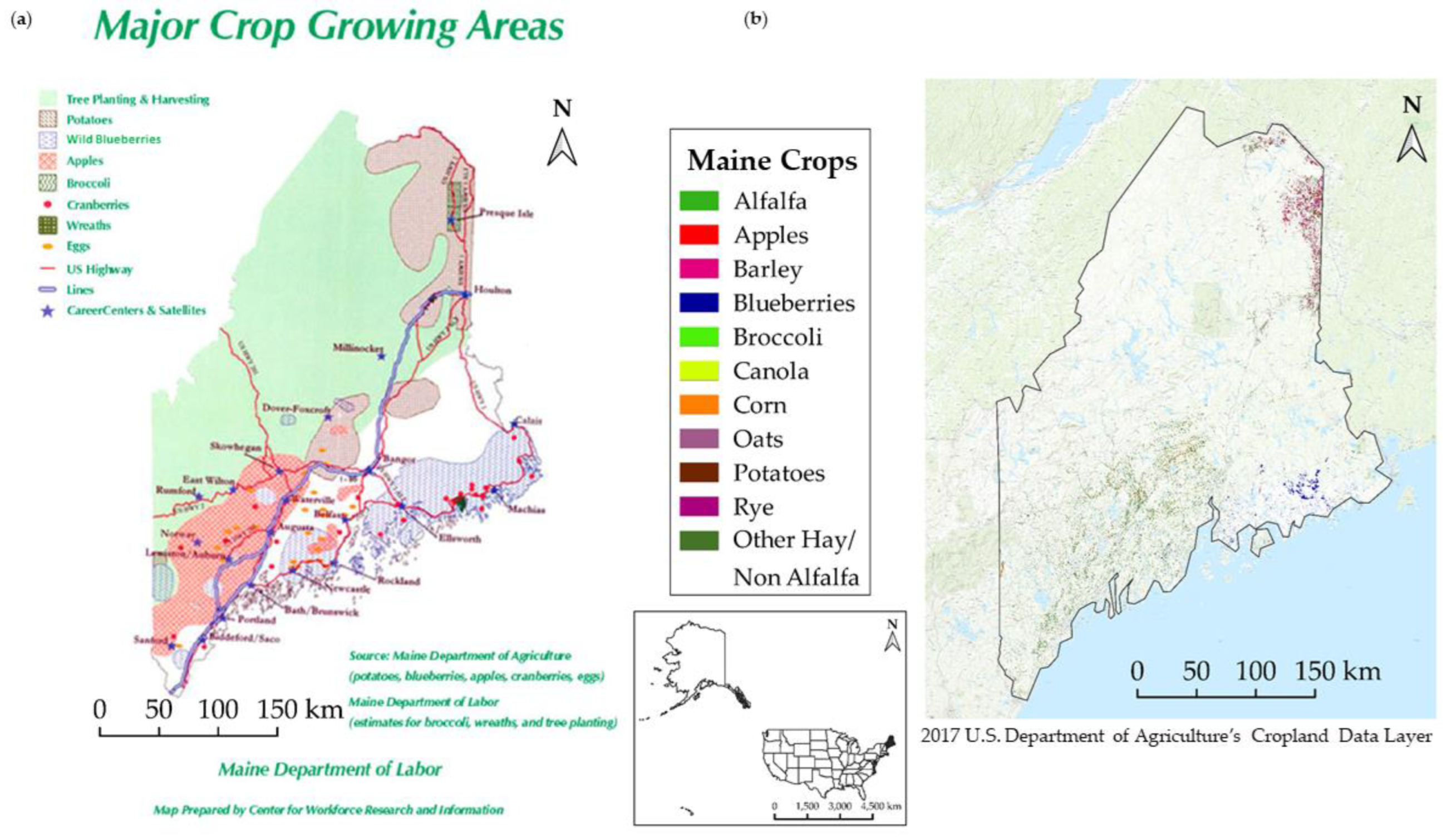
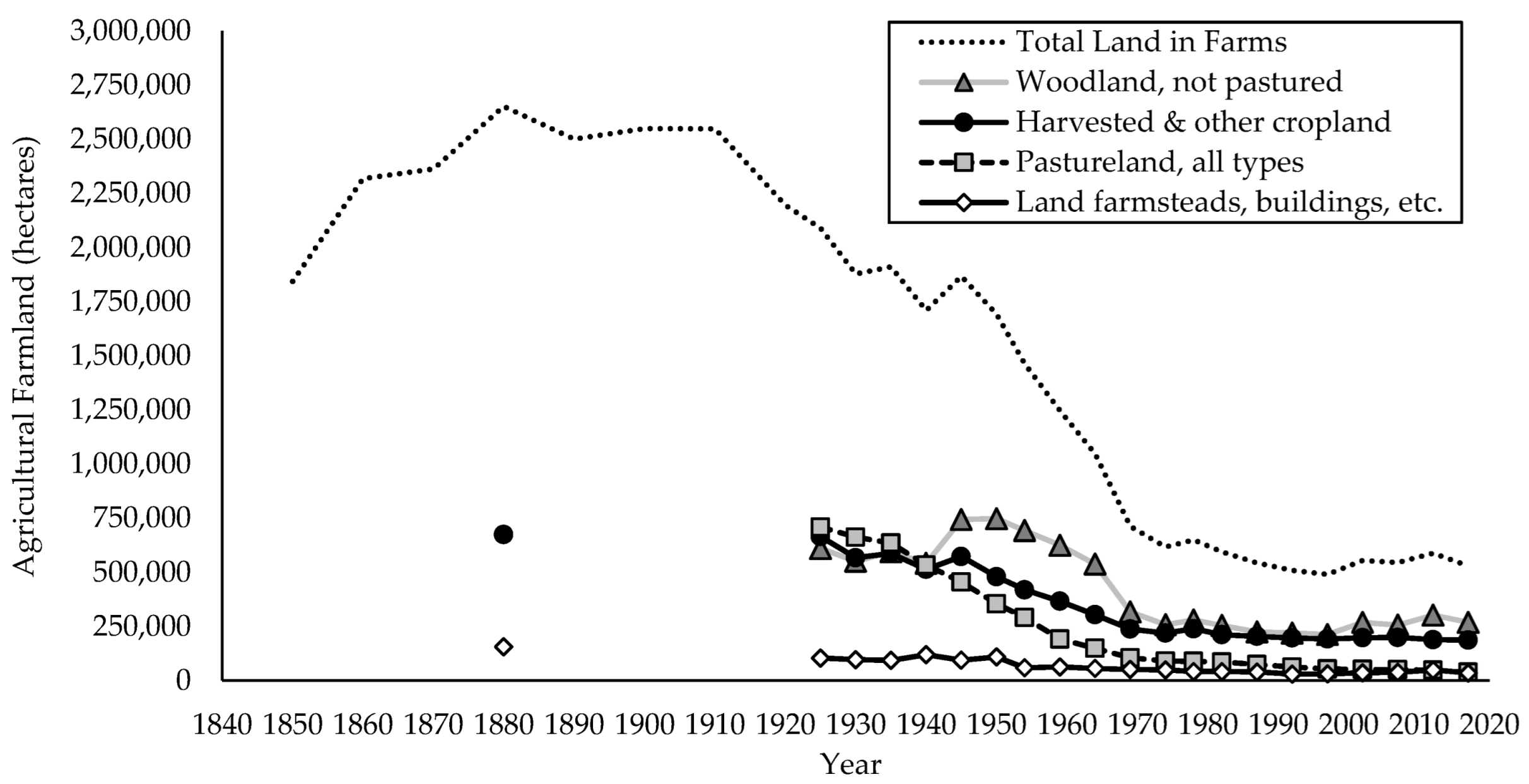
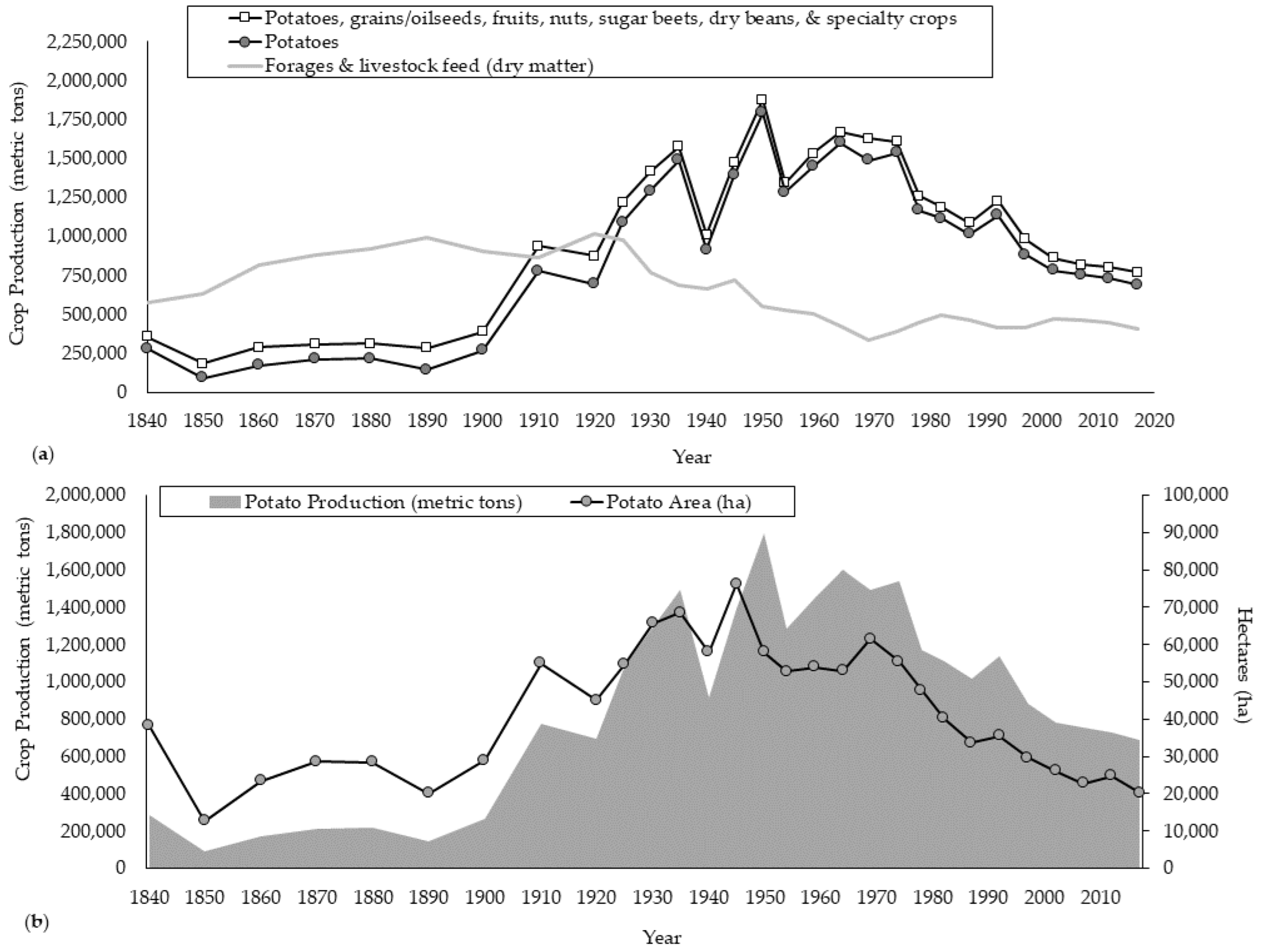
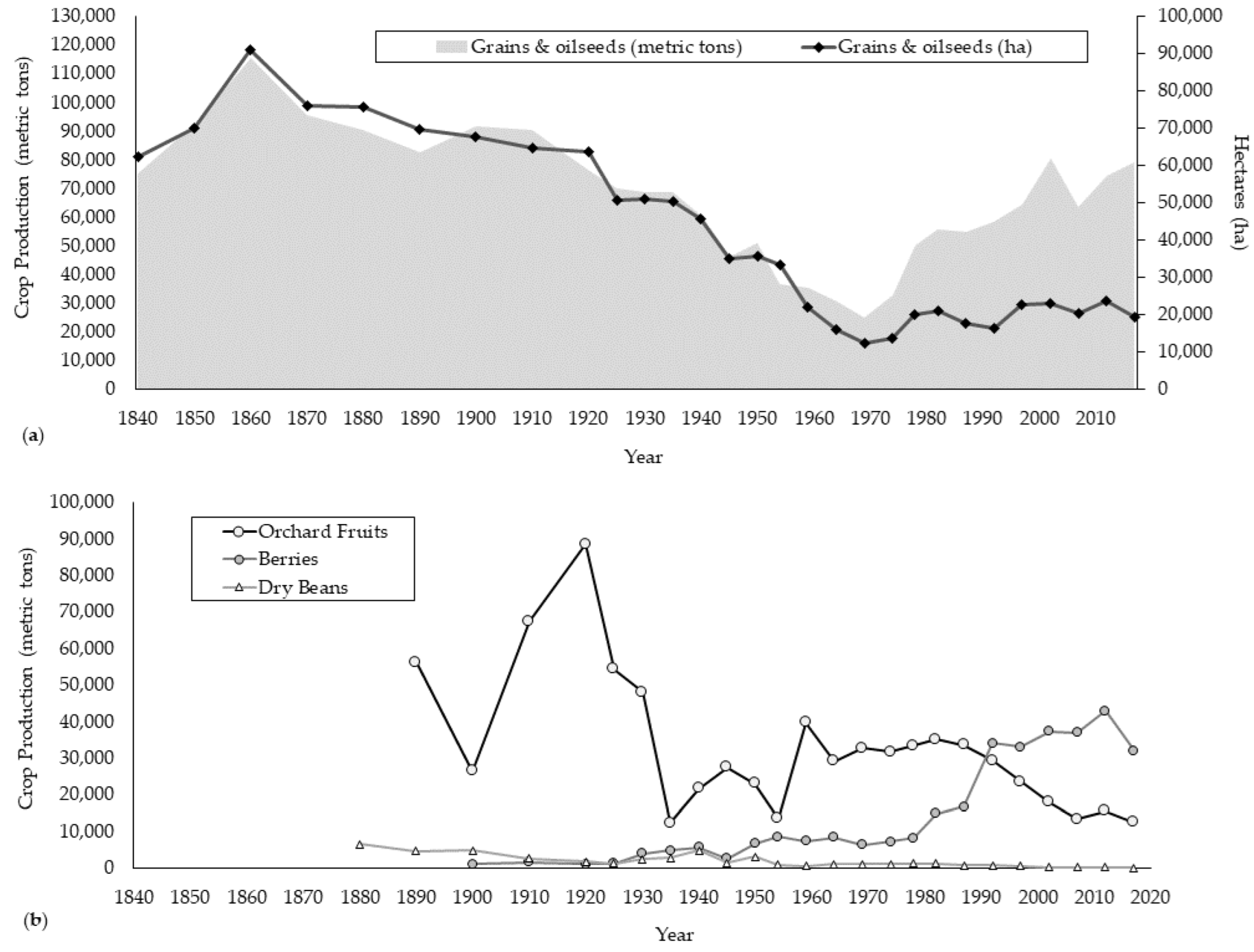
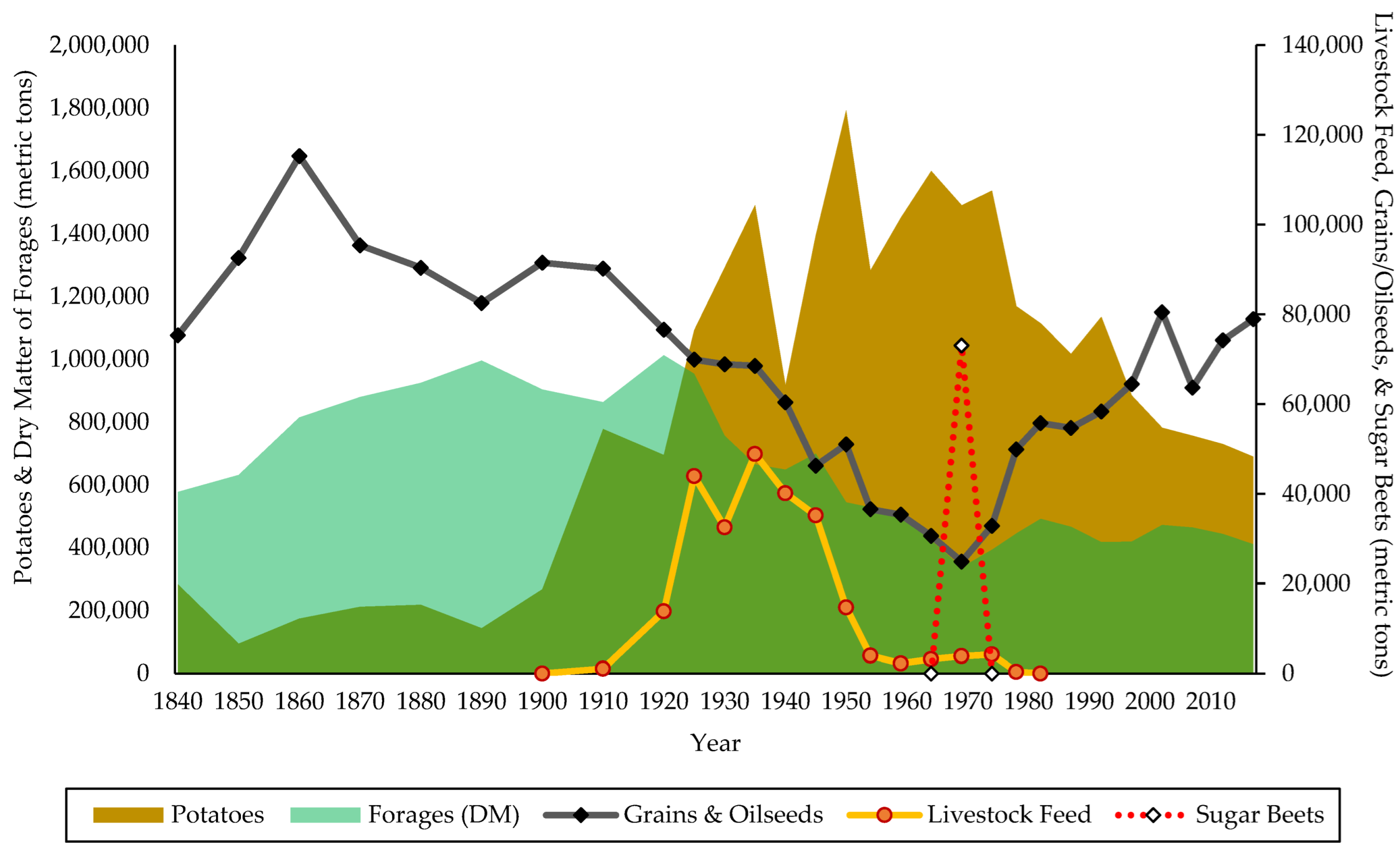
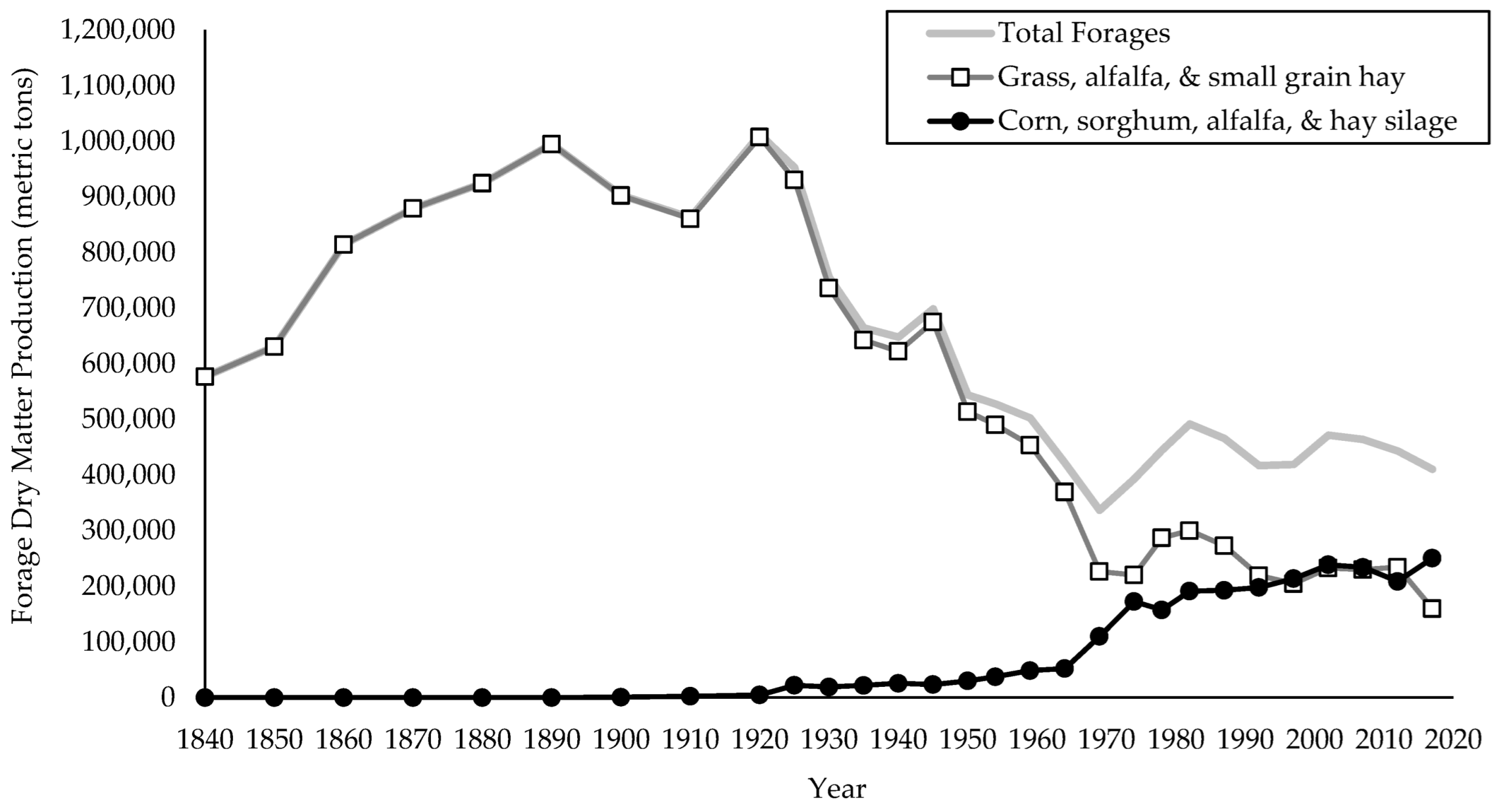
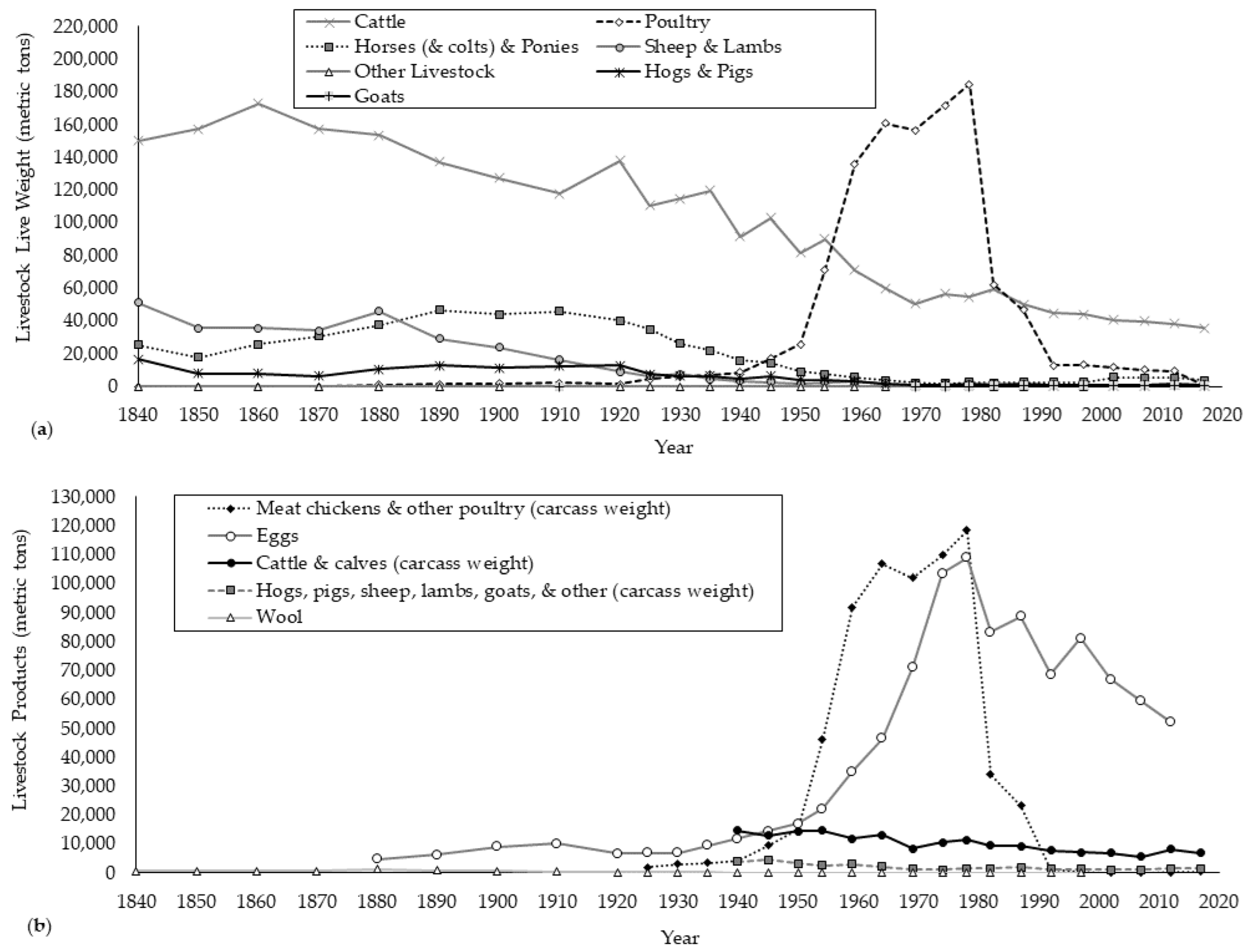
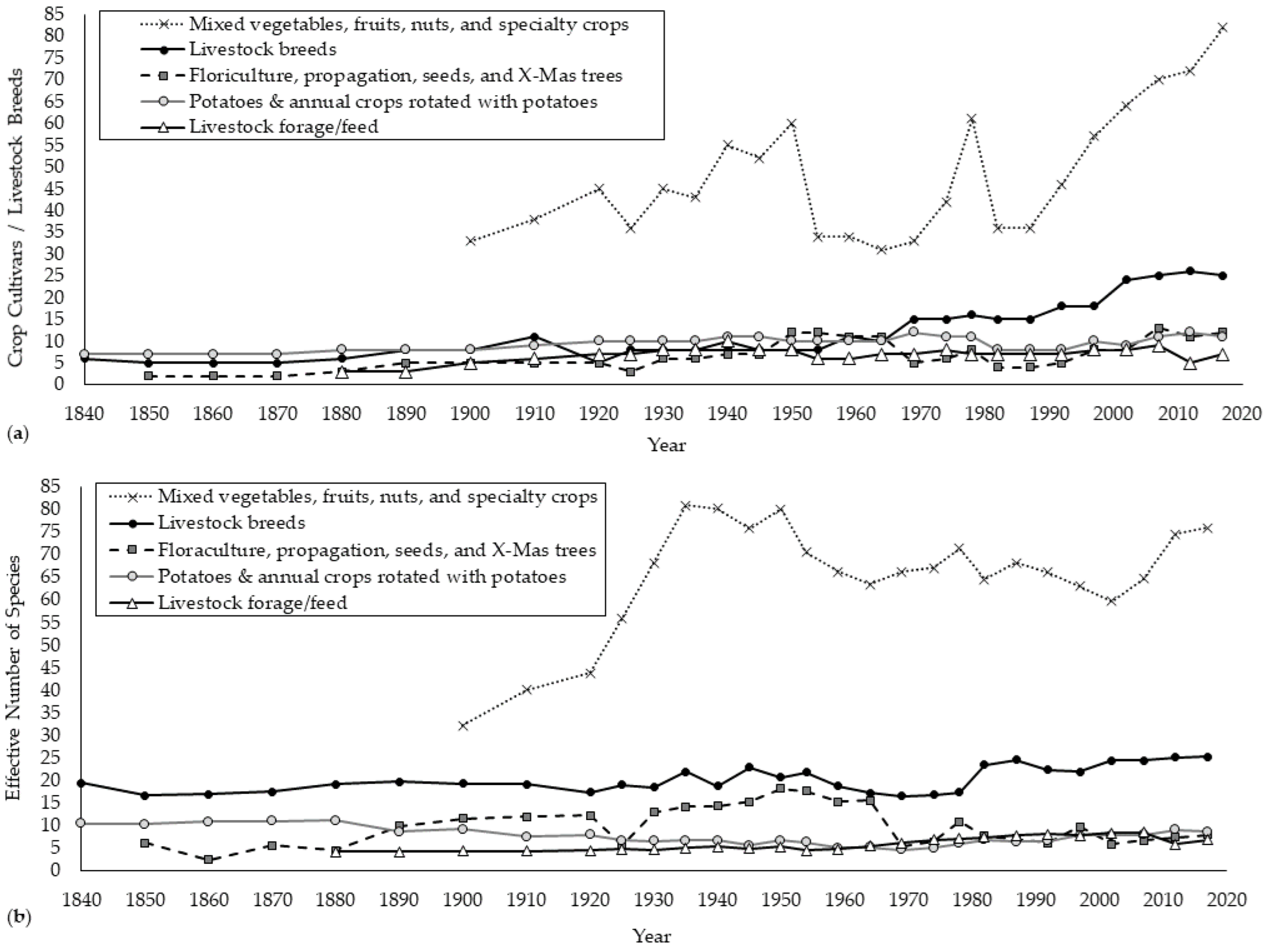
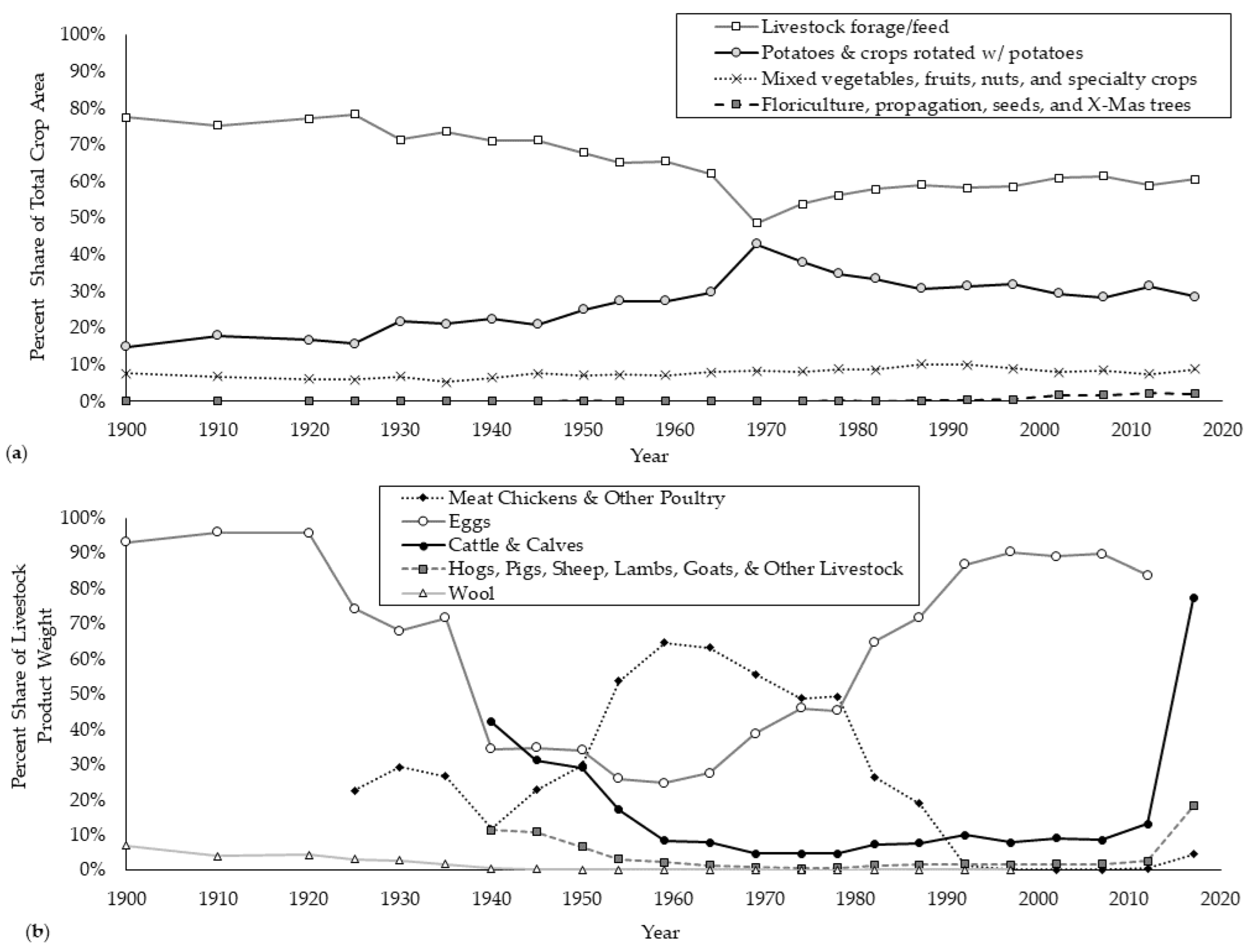


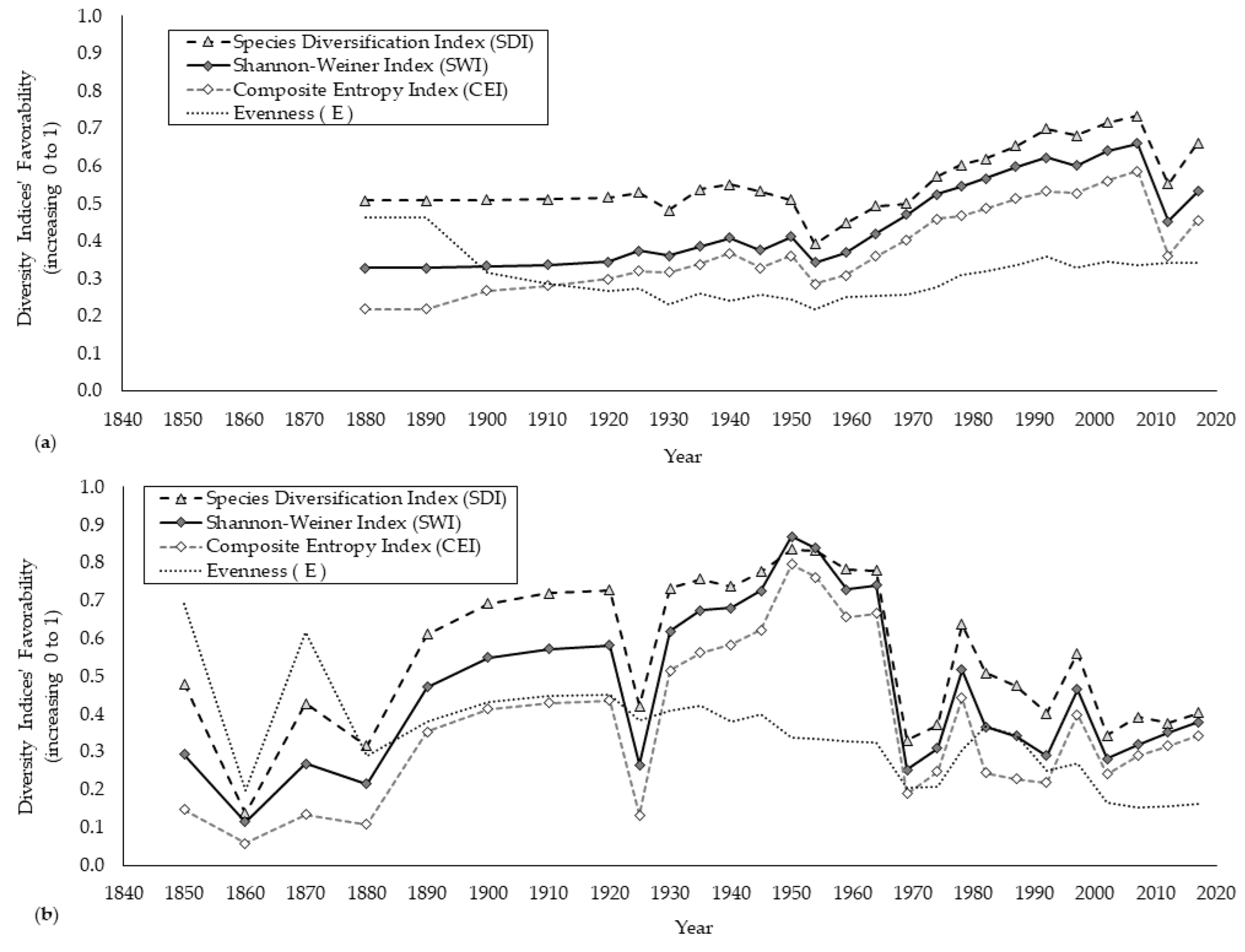
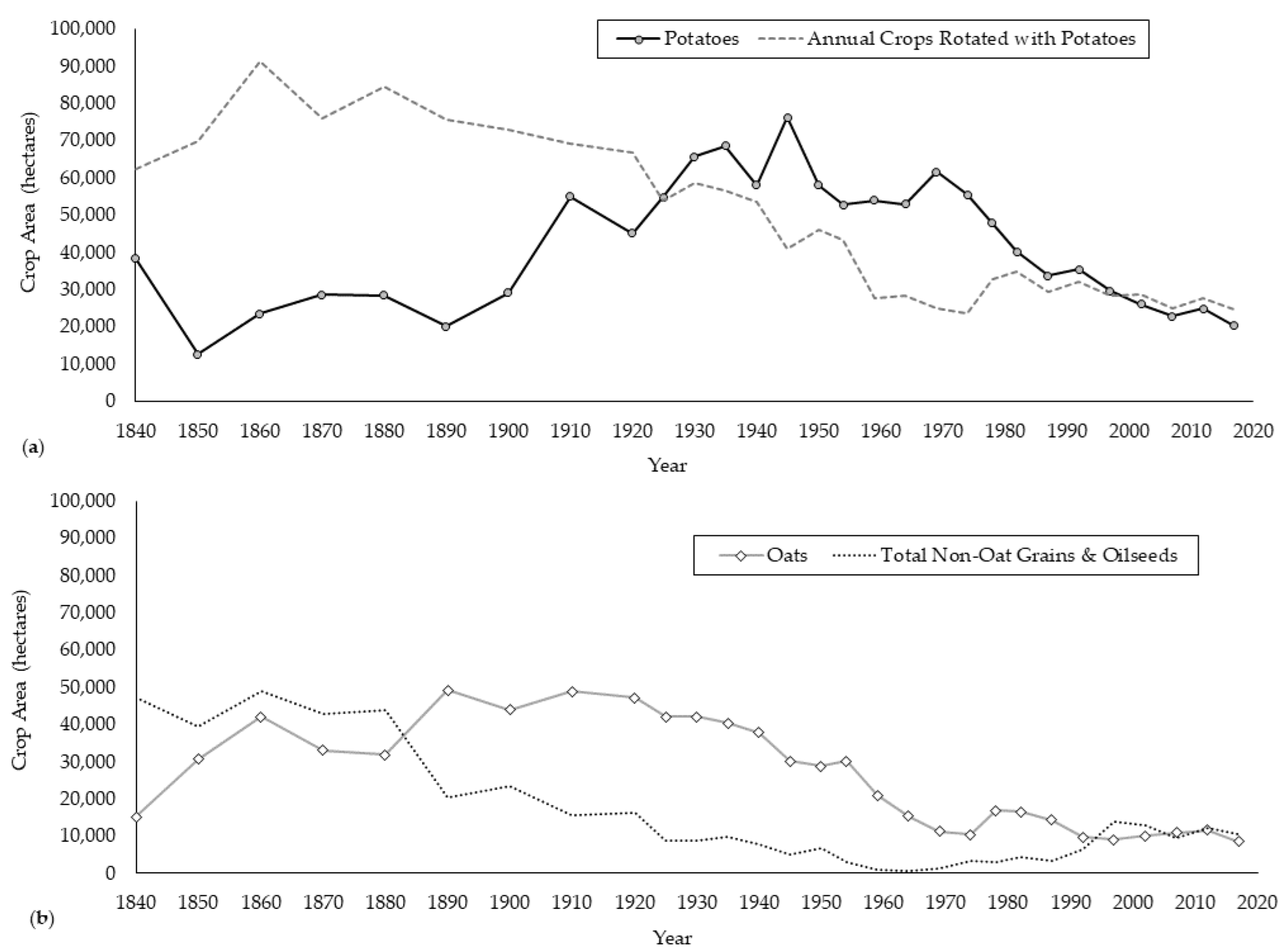
| Agricultural Category and Enterprise | Latin Name (Genus Species Subspecies) | Boom/Bust Years (Start–Peak–End) | ----Peak Production Year Estimate---- | 2017 Percent of Peak Prod. Year | ||||
|---|---|---|---|---|---|---|---|---|
| Farms | Area (ha) | Product 1 (metric t) | Real Value (2017 USD) | |||||
| Product | Value | |||||||
| LIVESTOCK | ||||||||
| Hogs | Sus domesticus | 1840–1840–1959 | 35,101 | - | 10,721 | 3,423,882 | 9.9% | 55.3% |
| Sheep (wool) | Ovis aries | 1840–1880–1900 | 36,396 | - | 1259 | 11,931,087 | 3.5% | 0.3% |
| Geese | Anser spp. domesticus | 1880–1890–1910 | 1911 | - | 13 | 71,179 | 3% | 1.7% |
| Horses 2 | Equus ferus caballus | 1840–1890–1945 | 47,420 | - | - | - | - | - |
| Pigeons | Columba livia domestica | 1910–1910–1910 | 287 | - | 0.40 | 6937 | 43.3% | 75.7% |
| Guinea Fowl | Numida meleagris | 1910–1910–1910 | 1073 | - | 3.64 | 27,828 | 10.6% | 2.3% |
| Angora Goat | Capra hircus aegagrus | 1900–1910–1920 | 393 | - | 0.293 | 3152 3 | 85.4% 3 | 22.8% 3 |
| FORAGES/ FEED | ||||||||
| Seed | Fabaceae/Poaceae family | 1850–1860–1890 | 9818 | 15,227 | 1460 | 6,223,061 | 1.1% | 1.8% |
| Forage hay | Poa spp. & others | 1840–1920–1959 | 46,790 | 496,582 | 1,094,358 | 212,351,008 | 30.2% | 22.8% |
| Root crops | Not specified | 1910–1920–1950 | 1872 | 633 | 8411 | 1,551,150 | 0% | 0% |
| Oats unthrsh. | Avena sativa | 1925–1925–1950 | 6272 | 6582 | 20,724 | 3,653,218 | 0% | 0% |
| Corn hogged | Zea mays | 1920–1935–1978 | 2273 | 1512 | 34,336 | 4,028,874 | 0% | 0% |
| Pumpkins | Cucurbita pepo | 1940–1940–1945 | 31 | 8 | 58 | 8850 | 0% | 0% |
| GRAIN/ OILSEED | ||||||||
| Rye | Secale cereale | 1840–1840–1870 | 5335 | 5409 | 3504 | 1,171,145 | 59.1% | 32.2% |
| Wheat | Triticum aestivum | 1840–1840–1935 | 23,487 | 22,598 | 23,083 | 13,002,123 | 1.6% | 0.7% |
| Flaxseed | Linum usitatissimum | 1850–1850–1910 | 98 | 124 | 15 | 7724 | 0% | 0% |
| Corn | Zea mays | 1840–1850–1920 | 36,109 | 22,852 | 44,453 | 7,052,906 | 68.2% | 68.9% |
| Barley | Hordeum vulgare | 1840–1860–1900 | 14,369 | 13,059 | 17,464 | 4,674,916 | 144% | 76.7% |
| Buckwheat | Fagopyrum esculentum | 1840–1900–1954 | 9727 | 10,235 | 11,046 | 3,725,345 | 0.4% | 1.0% |
| Small Grains | Not specified | 1925–1950–1964 | 350 | 2062 | n/a | n/a | 0% | n/a |
| VEGETABLES | ||||||||
| Dry peas | Pisum sativum | 1880–1880–1920 | 8531 | 1784 | 1495 | 1,736,056 | 0% | 0% |
| Dry beans | Fabaceae Family spp. | 1880–1880–1997 | 30,005 | 6852 | 4945 | 6,229,964 | 1.3% | 0.6% |
| Sweet potato | Ipomoea batatas | 1890–1890–1890 | 6 | 1.6 | 6 | 4309 | 142% | 126.3% |
| Sweet corn | Zea mays | 1900–1930–1950 | 7153 | 6654 | n/a | n/a | n/a | n/a |
| Cabbage | Brassica oleracea capitata | 1900–1935–1969 | 1273 | 242 | n/a | n/a | n/a | n/a |
| Squash | Cucurbita spp. | 1930–1940–2017 | 494 | 478 | n/a | n/a | n/a | n/a |
| Green beans | Phaseolus vulgaris | 1920–1945–1978 | 2397 | 1616 | n/a | n/a | n/a | n/a |
| FRUITS | ||||||||
| Grapes | Vitis vinifera | 1900–1900–1950 | 4350 | 20 | 125 | 74,441 | 118% | 192.5% |
| Apricots | Prunus armeniaca | 1910–1910–1910 | 48 | 7 | 0.57 | 605 | 0% | 0% |
| Currants | Ribes spp. | 1900–1910–1920 | 1076 | 32 | 35 | 111,189 | 1.1% | 4.6% |
| Cherries | Prunus avium/P. cerasus | 1890–1910–1930 | 3165 | 19 | 61 | 114,022 | 4.8% | 6.9% |
| Pears | Pyrus spp. | 1890–1910–1950 | 10,857 | 241 | 1016 | 234,295 | 3.9% | 16.4% |
| Blackberry | Rubus spp. | 1900–1920–1945 | 2198 | 114 | 127 | 388,062 | 6% | 7.7% |
| Plum/Prune | Prunus domestica | 1900–1920–1950 | 6792 | 54 | 264 | 379,093 | 2.2% | 1.2% |
| Apples | Malus domestica | 1890–1920–1978 | 34,600 | 24,396 | 87,622 | 47,753,831 | 14% | 24.8% |
| Strawberry | Fragaria × ananassa | 1900–1940–1940 | 2168 | 293 | 1518 | 1,946,278 | 31% | 121.9% |
| Raspberry | Rubus idaeus | 1900–1940–1945 | 1783 | 204 | 179 | 498,673 | 26.4% | 61.7% |
| Peaches | Prunus persica | 1900–1950–1964 | 1097 | 19 | 139 | 216,309 | 60.8% | 57.9% |
| TEXTILE/ OTHER | ||||||||
| Textiles | Silk, flax, & hemp | 1840–1840–1910 | 76 | 459 | 35 | n/a | 0% | n/a |
| Hops | Humulus lupulus | 1840–1870–1900 | n/a | 378 | 135 | 560,045 | 1.4% | 4.3% |
| Agricultural Category and Enterprise | Latin Name (Genus Species Subspecies) | Boom/Bust Years (Start–Peak–End) | ---Peak Production Year Estimate--- | 2017 Percent of Peak Prod. Year | ||||
|---|---|---|---|---|---|---|---|---|
| Farms | Area (ha) | Product 1 (metric t) | Real Value (2017 USD) | |||||
| Product | Value | |||||||
| LIVESTOCK | ||||||||
| Cattle (dairy) | Bos taurus | 1850–1900–2017 | 59,299 | - | 409,282 | 482,207,450 1 | 69.8% | 27.9% |
| Turkeys | Meleagris gallopavo domestica | 1930–1954–1969 | 567 | - | 1970 | 5,336,560 | 5.0% | 2.6% |
| Broilers | Gallus gallus domesticus | 1945–1978–1987 | 345 | - | 117,718 | 163,162,608 | 0.3% | 0.03% |
| Eggs (dozen) | Gallus gallus domesticus | 1950–1978–2012 | 822 | - | 108,958 | 162,158,469 | 47.8% 2 | 40.7% 2 |
| Ducks | Anas platrhynchos domesticus | 1974–1978–1982 | 74 | - | 689 | 654,121 | 6.5% | 6.5% |
| Rabbits | Oryctolagus cuniculus | 1978–1992–2002 | 59 | - | 67 | 414,407 | 31.1% | 8.9% |
| Quail | Coturnix coturnix | 1992–1997–2017 | 4 | - | 0.92 | 5511 | 73% | 125.8% |
| Emus | Dromaius novaehollandiae | 2002–2002–2012 | 6 | - | 0.94 | 10,076 | 33.3% 2 | 62.8% 2 |
| Angora Goat | Capra hircus aegagrus | 2002–2007–2017 | 37 3 | - | 0.81 3 | 8190 3 | 30.6% 3 | 8.8% 3 |
| Goats | Capra hircus | 1997–2007–2017 | 116 | - | 39 | 107,165 | 66.8% | 141% |
| Guinea Fowl | Numida meleagris | 2012–2012–2017 | 122 | - | 0.44 | 737 | 87.0% | 87.0% |
| FORAGES | ||||||||
| Sorghum | Sorghum bicolor | 1969–1974–1987 | 60 | 667 | 17,328 | 202,036 | 2.9% | 11.9% |
| Corn silage | Zea mays | 1964–1974–2017 | 805 | 15,122 | 466,462 | 8,226,001 | 83.5% | 227.5% |
| Alfalfa (hay) | Medicago sativa | 1954–1992–2017 | 774 | 13,995 | 52,437 | 13,815,513 | 37.9% | 30.7% |
| GRAIN/ OILSEED | ||||||||
| Oats | Avena sativa | 1840–1910–2017 | 22,029 | 48,963 | 61,432 | 17,683,787 | 32.0% | 21.5% |
| Sorghum | Sorghum bicolor | 1969–1969–1978 | 4 | 62 | 142 | 14,953 | 12.9% | 60.2% |
| Wheat | Triticum aestivum | 1974–1974–1982 2007–2012–2017 | 59 19 | 777 968 | 2073 2576 | 300,211 471,630 | 17.3% 13.9% | 30.3% 19.3% |
| Canola | Brassica napus | 1997–2002–2017 | 20 | 621 | 1131 | 510,770 | 5.1% | 4.3% |
| Barley | Hordeum vulgare | 1992–2002–2017 | 112 | 10,464 | 39,741 | 4,425,358 | 63.3% | 81.0% |
| Spelt/Emmer | Triticum spelta/T. turgidum | 2007–2007–2017 | 6 | 18 | 55 | 17,473 | 31.3% | 86.5% |
| Triticale | ×Triticosecale spp. | 2007–2007–2017 | 4 | 13 | 38 | 16,813 | 25.8% | 38.7% |
| Rye | Secale cereale | 2012–2012–2017 | 23 | 1687 | 6556 | 968,960 | 31.6% | 38.9% |
| POTATO + CROPS | ||||||||
| Potatoes | Solanum tuberosum | 1910–1950–2017 | 14,904 | 58,028 | 1,791,470 | 313,564,930 | 38.5% | 49.4% |
| Green peas | Pisum sativum | 1935–1964–1997 | 435 | 4373 | n/a | n/a | - | - |
| Sugar beets | Beta vulgaris vulgaris | 1964–1969–1974 | 141 | 3840 | 73,064 | 5,559,566 | 0% | 0% |
| Broccoli | Brassica oleracea var. italica | 1987–2012–2017 | 145 | 2555 | n/a | n/a | - | - |
| VEGETABLES | ||||||||
| Cucumbers | Cucumis sativus | 1900–1950–1964 | 982 | 328 | n/a | n/a | - | - |
| Lettuce | Lactuca sativa | 1930–1954–1969 | 168 | 308 | n/a | n/a | - | - |
| Carrots | Daucus carota sativus | 1935–1954–1978 | 302 | 172 | n/a | n/a | - | - |
| Dry peas | Pisum sativum | 1969–1969–1978 | 13 | 250 | 647 | 548,841 | 0% | 0% |
| Dry beans | Fabaceae Family spp. | 1969–1982–1997 | 115 | 1955 | 1122 | 2,124,836 | 5.7% | 1.8% |
| FRUITS | ||||||||
| Grapes | Vitis vinifera | 1974–1982–2017 | 60 | 15 | 150 | 99,865 | 98.5% | 249.2% |
| Strawberry | Fragaria × ananassa | 1982–1987–2017 | 163 | 238 | 947 | 1,725,185 | 49.6% | 137.5% |
| Blueberry | ||||||||
| Highbush | Vaccinium corymbosum | 1940–1987–2017 | 110 | 982 | 1118 | 5,288,894 | 30.8% | 31.4% |
| Lowbush | Vaccinium angustifolium | 1982–2014–2020 | 500 | 9225 | 47,355 | 59,039,649 | 45.4% 2 | 20.9% 2 |
| Cranberry | Vaccinium oxycoccos | 1997–2007–2017 | 40 | 121 | 841 | 1,457,458 | 30.4% | 11.7% |
| Agricultural Category and Enterprise | Latin Name (Genus Species Subspecies) | Growth Years (Peak–Start–Recent) | ------Recent Year Estimate------ | 2017 Percent of Peak Prod. Year | ||||
|---|---|---|---|---|---|---|---|---|
| Farms | Area (ha) | Product 1 (Metric Tons) | Real Val. (2017 USD) | |||||
| Product | Value | |||||||
| LIVESTOCK | ||||||||
| Pheasants | Phasianus colchicus | None–1992–2012 | 6 | - | 7 | n/a | n/a | n/a |
| Bison | Bison spp. | None–2002–2017 | 12 | - | 13 | 101,000 | 100% | 100% |
| Deer (tame) | Odocoileus virginianus | None–2002–2017 | 37 | - | 73 | 1,397,000 | 100% | 100% |
| Pigeons | Columba livia domestica | 1910–1992–2017 | 15 | - | 0.17 | 3547 | 43.3% | 43.3% |
| Peafowl 2 | Pavo & Afropavo spp. | None–1910; 2012–2017 | 25 | - | n/a | 721 2 | - | - |
| FORAGES | ||||||||
| Alfalfa (haylage) | Medicago sativa | None–2002–2017 | 139 | 5750 | 87,400 | 4,268,000 | 100% | 100% |
| GRAIN/OILSEED | ||||||||
| Sorghum | Sorghum bicolor | None–2012–2017 | 3 | 8 | 142 | 2187 | 12.9% | 12.9% |
| Sunflower seed | Helianthus annuus | None–1997–2017 | 1 | 9 | 9 | 3560 | 100% | 100% |
| Corn | Zea mays | 1850–1974–2017 | 82 | 2929 | 30,327 | 4,859,275 | 68.2% | 68.2% |
| VEGETABLES | ||||||||
| Sweet potato | Ipomoea batatas | None–2002–2017 | 34 | 4 | 9 | 35,084 | 100% | 100% |
| FRUITS | ||||||||
| Peaches | Prunus persica | 1950–1982–2017 | 118 | 18 | 84 | 303,117 | 60.8% | 60.8% |
Publisher’s Note: MDPI stays neutral with regard to jurisdictional claims in published maps and institutional affiliations. |
© 2022 by the author. Licensee MDPI, Basel, Switzerland. This article is an open access article distributed under the terms and conditions of the Creative Commons Attribution (CC BY) license (https://creativecommons.org/licenses/by/4.0/).
Share and Cite
Hoshide, A.K. Back to the Future: Agricultural Booms, Busts, and Diversification in Maine, USA, 1840–2017. Sustainability 2022, 14, 15907. https://doi.org/10.3390/su142315907
Hoshide AK. Back to the Future: Agricultural Booms, Busts, and Diversification in Maine, USA, 1840–2017. Sustainability. 2022; 14(23):15907. https://doi.org/10.3390/su142315907
Chicago/Turabian StyleHoshide, Aaron Kinyu. 2022. "Back to the Future: Agricultural Booms, Busts, and Diversification in Maine, USA, 1840–2017" Sustainability 14, no. 23: 15907. https://doi.org/10.3390/su142315907
APA StyleHoshide, A. K. (2022). Back to the Future: Agricultural Booms, Busts, and Diversification in Maine, USA, 1840–2017. Sustainability, 14(23), 15907. https://doi.org/10.3390/su142315907






